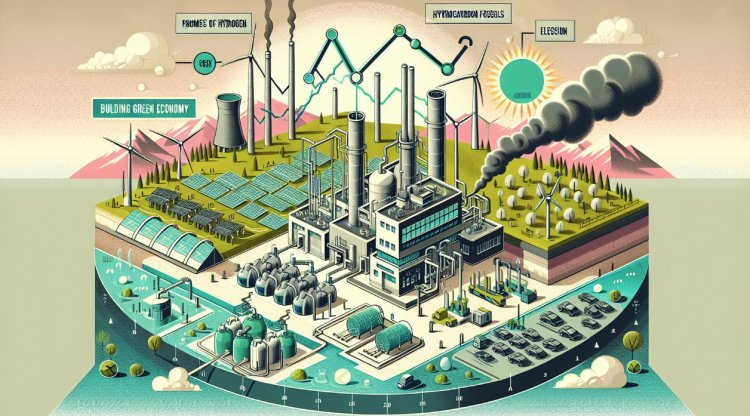Can hydrogen help the world reach net zero?
Uncover the potential of hydrogen as a clean energy source in the fight against climate change. Can hydrogen power the world's transition to net zero emissions? Explore the challenges and opportunities.

Introduction
Hydrogen, the lightest and most abundant molecule in the universe, holds incredible potential as a clean and efficient energy source. As the world shifts towards cleaner forms of energy, hydrogen has emerged as a key player in transforming sectors from heavy industry to transportation. In this blog, we will explore the race to build a massive new hydrogen economy, starting with the largest green hydrogen plant in Europe located in southern Spain's Ciudad Real province.
Powering the Future with Green Hydrogen
The green hydrogen plant in Ciudad Real, built by Iberdrola, the largest utility company in Europe, utilises solar panels to generate electricity for the process of electrolysis. Electrolysis uses electricity to split water into hydrogen and oxygen, with hydrogen being used to produce ammonia, a potential zero-carbon fuel. The plant stores excess hydrogen production during the day for use at night, ensuring a continuous supply to customers. Iberdrola plans to invest three billion euros in hydrogen projects by 2030, expanding its operations across the Iberian Peninsula, the United States, Australia, Brazil, and beyond.
The Transition to Green Hydrogen
Currently, hydrogen production largely relies on breaking apart hydrocarbon fossil fuels, resulting in significant carbon dioxide emissions. However, the green hydrogen process, while currently more expensive, offers a cleaner alternative. Iberdrola, with its extensive portfolio of solar and wind farms, aims to drive down the cost of green hydrogen production as renewable energy costs decrease and carbon pricing systems become more stringent. The goal is to create a hydrogen economy where customers can access green products without paying a premium, thus incentivizing the use of green hydrogen and decarbonising the entire supply chain.
Exploring the Colours of Hydrogen
Hydrogen comes in various forms, each with its own production method and environmental impact. Pink hydrogen, produced through electrolysis powered by nuclear energy, offers an alternative to renewable energy. Grey hydrogen is produced by splitting methane gas, while black and brown hydrogen are derived from coal. Blue hydrogen, produced by breaking up fossil fuels while capturing and storing carbon dioxide, is considered the most cost-effective option in the near term. Finally, there's emerald hydrogen, an innovative concept that utilizes hydrocarbons like methane to produce hydrogen without emitting carbon dioxide.
Investing in the Hydrogen Revolution
The development of a full-scale hydrogen economy requires significant capital investment, making it an attractive opportunity for many investment funds. HY24, a fund dedicated to hydrogen investments, has raised two billion euros and attracted major industrial and financial companies like Airbus and Allianz. The fund covers the entire value chain of hydrogen, from upstream projects involving a shift from grey to green hydrogen to more exploratory projects in the areas of mobility and renewable power generation.
Europe's Role in the Hydrogen Transition
Europe has been at the forefront of hydrogen projects in recent years. However, European policymakers must create a more business-friendly market system to maintain their leading position. The hydrogen industry requires collaboration between governments, private sector funding, and supportive regulatory frameworks. Failure to address these factors could result in the loss of energy-intensive industries and hinder progress toward decarbonisation.
The Global Race for Hydrogen
Competition among governments to invest in hydrogen has intensified, with the European Union (EU) and the United States leading the way. The EU has been compelled to respond to the US Inflation Reduction Act, which offers substantial subsidies for clean hydrogen production. Japan and other countries are also stepping up their efforts to develop low-carbon, green hydrogen. Policymakers and the private sector must work together to provide adequate funding and drive the hydrogen revolution forward.
Transforming the steel industry with hydrogen
SSAB, Sweden's largest steel company and a major carbon emitter, has made significant strides in reducing its carbon footprint. By replacing coal with green hydrogen in their steel production process, SSAB has achieved a 10% reduction in Sweden's carbon dioxide footprint. This breakthrough demonstrates the potential of hydrogen in industrial decarbonisation and positions SSAB as a leader in sustainable steel production.
Hydrogen-Powered Aviation: A Greener Future
ZeroAvia, a start-up based in the UK, is pioneering the use of hydrogen fuel cells in power planes. By utilizing fuel cells, which convert hydrogen and oxygen into electricity, ZeroAvia aims to eliminate the greenhouse gas emissions associated with conventional jet fuel. Their successful test flights have shown that hydrogen can offer a clean alternative for aviation, a sector that has traditionally been challenging to decarbonize.
The Future of Hydrogen: A Key Component of the Energy Transition
While hydrogen may not be the solution for all energy challenges, its potential to decarbonise industries and transportation is undeniable. As the world seeks to achieve net-zero emissions, hydrogen will play a significant role alongside other renewable energy sources. The hydrogen economy is expected to comprise a substantial portion of the world's energy supply and investments in hydrogen technologies and infrastructure are crucial to realizing this vision.
Conclusion
The race to build a hydrogen economy is well underway, with companies and governments investing billions of euros and dollars in hydrogen projects. From green hydrogen plants to hydrogen-powered aviation, the promises of hydrogen are becoming a reality. While challenges remain, such as cost competitiveness and the need for supportive regulatory frameworks, the transition to a hydrogen-based future is gaining momentum. With continued investment and collaboration, hydrogen has the potential to transform industries, decarbonize transportation, and contribute to a more sustainable and cleaner world.



 admin
admin 










